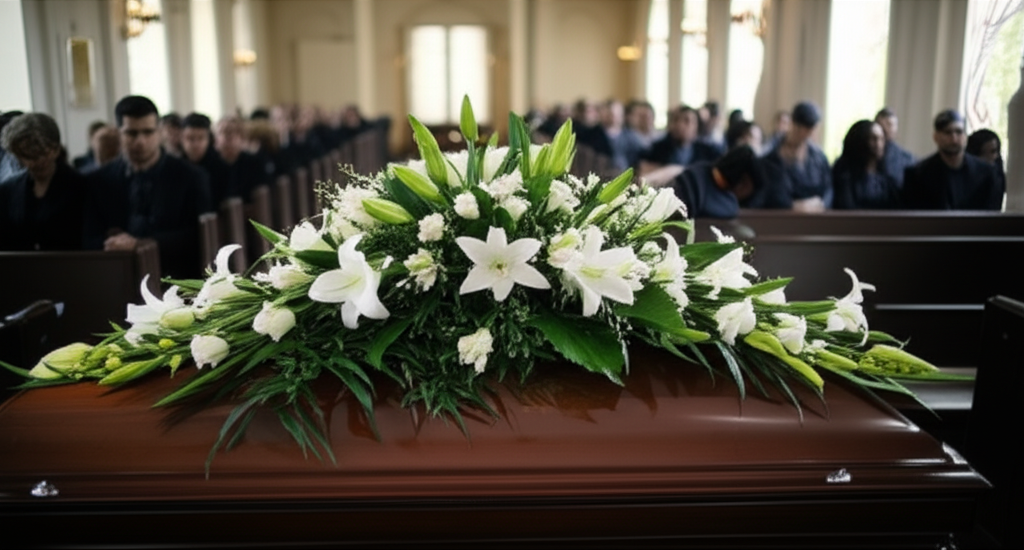Funeral Planning for Hospice Patients: A Sensitive Guide
Navigating the journey of hospice care with a loved one is a profound experience, filled with moments of deep connection and emotional challenges. During this sensitive time, thinking about funeral arrangements can feel overwhelming. However, planning ahead can be a compassionate act of love, providing comfort and clarity for everyone involved. This guide offers a sensitive approach to funeral planning for hospice patients, ensuring their final wishes are honored with dignity and respect.
The Compassionate Benefits of Pre-Planning a Funeral in Hospice Care
Proactively arranging a funeral while a loved one is in hospice care offers profound emotional and practical benefits. It transforms a challenging task into a meaningful process of honoring a life, providing peace for both the patient and their family.
How pre-need arrangements for the terminally ill alleviate emotional burden
When a loved one passes, the family is often left to make dozens of difficult decisions in a short period while navigating intense grief. Pre-planning removes this pressure. By making choices in a calm and thoughtful environment, families can spare themselves the stress of logistical and financial decisions during their time of loss. This allows them the space they need to grieve, support one another, and focus on remembering their loved one, rather than being consumed by arrangements.
Ensuring a hospice patient's final wishes are honored and respected
Every person is unique, and their final farewell should reflect that. Pre-planning is the most effective way to ensure a service truly honors the patient’s values, beliefs, and personality. When the individual can participate, they can specify their preferences for burial or cremation, music, readings, and other personal touches. This ensures the tribute is a genuine reflection of their life. Taking the step to plan ahead is a gift of certainty, preventing family disputes and eliminating any guesswork about what their loved one would have wanted.
How proactive end-of-life planning provides peace of mind and control
For a person with a terminal illness, many aspects of life can feel beyond their control. Participating in their own funeral planning can restore a sense of agency and provide profound peace of mind. Knowing their wishes are documented and will be carried out can be incredibly comforting. For the family, this proactive planning provides reassurance that they are fulfilling their loved one's final requests, bringing solace during a difficult transition.

How to Gently Discuss Funeral Plans with a Terminally Ill Loved One
Approaching the topic of funeral arrangements with a terminally ill loved one requires immense sensitivity and compassion. The goal is to create a safe space for them to share their wishes if they are ready, not to force a conversation they are not prepared for.
Recognizing cues and finding the right moment for a sensitive conversation
Timing is crucial. Look for natural openings or cues from your loved one. They might make comments about the future, express how they’d like to be remembered, or mention feeling tired of their illness. These can be gentle entry points. Choose a quiet, private moment when you are both calm and free from distractions. If they seem distressed or withdrawn, it’s best to wait for a more receptive time.
Best practices for communicating compassionately about end-of-life wishes
When you do talk, lead with empathy and an open heart. Use gentle, open-ended questions like, "Have you ever thought about how you’d like to be remembered?" or "I want to make sure we honor your wishes. Is this something you’d be open to talking about?" The most important part is to listen actively. Allow for silence, validate their feelings, and let them guide the conversation at their own pace. Reassure them that this discussion is about honoring them, not about giving up.
The supportive role of the hospice team in facilitating difficult family discussions
You are not alone in this process. Hospice teams, including social workers, chaplains, and counselors, are trained to facilitate these sensitive conversations. They can act as a neutral third party, helping to navigate complex family dynamics and emotional hurdles. They can also provide resources and support to ensure the discussion is productive and respectful of the patient's emotional and spiritual needs.
Explaining funeral plans to a hospice patient with dignity and care
Frame the conversation around their legacy and the celebration of their life. Explain that planning is an act of love that provides comfort to those they will leave behind. By sharing their wishes, they give their family a clear path to follow, allowing everyone to focus on healing and remembrance when the time comes. Always respect their decision if they choose not to discuss the topic, and let them know the door is always open if they change their mind.
A Step-by-Step Guide to Arranging a Funeral for a Hospice Patient
Planning a funeral involves a series of thoughtful decisions. Breaking it down into manageable steps can make the process feel less daunting and ensure all important details are covered.
Step 1: Choosing between cremation and burial options for hospice patients
The first major decision is the method of disposition. This is a deeply personal choice often influenced by religious beliefs, family traditions, or individual preferences. A traditional burial involves interment in a cemetery, which may be preceded by a viewing or visitation. Cremation services offer more flexibility, as the remains can be kept, scattered, or interred. Discussing these options openly can help determine the most fitting choice.
Step 2: How to select the right funeral home or cremation provider
Choosing a funeral home is a critical step, as they will be your guide through this process. Look for a provider with a reputation for compassion, transparency, and experience in serving hospice families. The team at Oliveira Funeral Homes is dedicated to providing sensitive, personalized care, understanding the unique emotional needs of families during this time. We are here to answer all your questions and help you navigate every detail with dignity.
Step 3: Deciding on the type of service: traditional, memorial, or celebration of life
The service itself is a tribute to your loved one’s life. A traditional service often follows a set structure, while a memorial service can be held with or without the remains present. A celebration of life is typically a more informal gathering focused on sharing positive memories. There is no right or wrong choice; the best option is one that reflects the personality and spirit of the person being honored. You can explore a full services overview to understand all available options.
Step 4: Gathering essential documents and information for final arrangements
Your funeral director will need specific information to file the death certificate and other legal paperwork. It is helpful to gather these items in advance:
- Full legal name and address
- Date and place of birth
- Social Security number
- Parents' names, including mother's maiden name
- Marital status and spouse's name
- Military service records (e.g., DD-214), if applicable
Personalized Memorial Service Ideas to Honor a Hospice Patient's Life
A memorial service is a powerful opportunity to celebrate a unique life and create a space for collective healing. Personalizing the service makes the tribute more meaningful and helps tell the story of your loved one.
Creating meaningful tributes with personalized music, readings, and photos
Incorporate elements that were special to your loved one. Create a playlist of their favorite songs, from hymns to classic rock. Select readings, poems, or scriptures that resonated with their beliefs and values. A photo slideshow or video montage is a beautiful way to share cherished moments and milestones, allowing guests to reminisce and celebrate a life well-lived.
Interactive memorial ideas like memory jars and candle lighting ceremonies
Engaging guests can create a deeply moving experience. Set up a "memory jar" or guest book where attendees can write down and share their favorite stories or anecdotes. A candle lighting ceremony is another powerful tribute, where each lit candle can represent a cherished memory, a prayer, or a quality of the person being honored. These interactive elements foster a sense of shared remembrance and support.
How to incorporate a loved one’s hobbies and passions into the service
Let the service reflect what they loved. If they were an avid gardener, give guests seed packets to plant in their memory. If they were a passionate sports fan, encourage guests to wear their favorite team's colors. Displaying their artwork, crafts, or collections on a memory table can also create a beautiful focal point that speaks to their unique personality and passions.
Lasting memorials: planting a tree, creating a scholarship, or online tributes
A tribute doesn't have to end with the service. Creating a lasting memorial provides an ongoing way to honor their legacy. Planting a tree or a memorial garden offers a living tribute and a quiet place for reflection. Establishing a scholarship fund in their name can support a cause they were passionate about. An online tribute page also allows friends and family from afar to share memories and condolences, creating a permanent digital space for remembrance.
Understanding the Key Legal Aspects of Funeral Planning in Hospice
Navigating the legal requirements of end-of-life planning is essential to ensure a person's final wishes are legally protected and smoothly carried out. Formalizing these plans can prevent confusion and conflict for the family.
Why advance directives and living wills are crucial for end-of-life care
Advance directives are legal documents that allow an individual to state their preferences for medical treatment in the event they can no longer communicate. A living will specifies which life-sustaining treatments they do or do not want. These documents are vital in hospice care, as they empower the patient to make their own healthcare decisions and ensure their wishes for comfort and dignity are respected.
How a will, trust, and durable power of attorney impact final arrangements
While often thought of together, these documents serve different purposes. A Last Will and Testament outlines the distribution of assets after death and can name an executor. A trust can also manage assets and may help avoid probate. A durable power of attorney for healthcare designates a person (a healthcare proxy) to make medical decisions on their behalf if they become incapacitated. It's important to note that a power of attorney ends at death, so it doesn’t grant authority over funeral arrangements.
Appointing an agent to control disposition of remains to avoid family disputes
To ensure funeral wishes are followed, an individual can legally appoint an agent specifically to control the disposition of their remains. This designated person has the legal authority to make decisions about the funeral, burial, or cremation, superseding the rights of the next of kin. This can be a crucial step in preventing disagreements among surviving family members who may have different ideas about the arrangements.
What you need to know about death certificates and burial permits
After a death, a legally registered death certificate is required. The hospice team and funeral home work together to complete and file this document. Your funeral director at Oliveira Funeral Homes will handle this process, as well as securing any necessary burial or cremation permits. It is recommended to obtain multiple certified copies of the death certificate, as they will be needed for handling financial accounts, insurance claims, and other official matters.
How to Navigate Funeral Costs and Financial Assistance for Hospice Families
The financial aspect of funeral planning can be a source of stress for many families. Understanding the costs and available resources can help you make informed decisions that honor your loved one without creating a financial burden.
Understanding pre-paid funeral plans and burial insurance for the terminally ill
One of the most effective ways to manage funeral costs is through pre-payment. When you pre-plan and pre-pay for a funeral, you can often lock in today’s prices, protecting your family from future inflation. Burial insurance is a type of small life insurance policy designed specifically to cover final expenses. These tools provide peace of mind, ensuring that funds are set aside and ready when they are needed.
Accessing government benefits: Social Security, VA, and Medicaid assistance
Several government programs offer financial assistance. The Social Security Administration provides a one-time lump-sum death benefit of $255 to an eligible surviving spouse or child. For eligible veterans, the Department of Veterans Affairs (VA) provides burial benefits, which can include a burial allowance, a plot, and a headstone. Oliveira Funeral Homes is proud to assist families in securing these benefits and providing dignified veterans' services. Some state Medicaid programs may also offer a small allowance for funeral costs.
Finding support from charitable organizations and community resources
For families facing financial hardship, various non-profit organizations and community groups may offer assistance. Religious organizations, fraternal societies, and local charities sometimes have funds available to help cover funeral expenses for those in need. Your hospice social worker or funeral director can often help connect you with these local resources.
Cost-effective alternatives like whole body donation and green burials
There are also cost-effective alternatives to traditional services. Whole body donation to a medical school or research institution often covers the cost of cremation, with the remains returned to the family afterward. Green burials, which avoid embalming and use biodegradable caskets, can also be a more affordable and environmentally friendly option for families to consider.
What to Do Immediately When a Hospice Patient Passes Away
The moments following the death of a loved one can be disorienting. Knowing the proper steps to take can provide a sense of order and allow you to navigate this difficult time with confidence.
Why you should contact your hospice provider first, not 911
When a death is expected and occurs at home under hospice care, there is no need to call 911 or other emergency services. The first and most important call to make is to your hospice provider's 24-hour support line. They are prepared for this moment and will guide you through the next steps with compassion and professionalism.
The process of death pronouncement and handling initial legal paperwork
A hospice nurse will come to the home to officially pronounce the death. This is a necessary legal step. The nurse will also handle the initial paperwork required for the death certificate, documenting the time and cause of death. This process is handled with the utmost respect for both the deceased and the grieving family, allowing you time and space.
Coordinating with the chosen funeral home for transportation and care
Once the death has been pronounced, the hospice nurse will contact the funeral home you have selected. This is why having pre-planned with a provider like Oliveira Funeral Homes is so helpful. Our compassionate staff is available 24/7 to transport your loved one into our care with dignity and respect. There is no rush; families are given the time they need to say their final goodbyes before transportation occurs.
Notifying family, friends, and handling immediate practical tasks
After your loved one is in the care of the funeral home, you can begin notifying close family and friends. It can be helpful to delegate this task to a trusted relative or friend to ease your burden. Immediate practical tasks may include arranging for the care of pets or making sure the home is secure. Take these steps at your own pace; there is no need to do everything at once.
Finding Emotional and Grief Support for Families Planning a Hospice Funeral
Planning a funeral while grieving is one of life’s most difficult tasks. It is essential for caregivers and family members to access emotional support systems to help navigate their loss both during and after the funeral planning process.
Utilizing hospice bereavement services before and after a loss
One of the most valuable aspects of hospice care is that support doesn't end when your loved one dies. Hospice providers offer bereavement services to families for up to 13 months after a loss. This can include counseling, support groups, and check-in calls. This anticipatory and ongoing grief support is a vital resource for helping families process their emotions in a healthy way.
Where to find grief counseling and support groups for children and adults
Beyond hospice, many community resources are available. Local hospitals, community centers, and places of worship often host grief support groups for adults, children, and teens. Professional grief counselors can provide one-on-one therapy to help individuals navigate the complex emotions of loss. Online support groups also offer a convenient and accessible way to connect with others who understand what you are going through.
The importance of self-care for caregivers during the funeral planning process
Caregivers often put their own needs aside, but during the funeral planning process, self-care is more important than ever. Grief can take a physical and emotional toll. Be sure to get enough rest, eat nourishing meals, and allow yourself moments of quiet reflection. Don’t be afraid to ask for and accept help from friends and family with practical tasks like meals or errands. Tending to your own well-being will give you the strength to honor your loved one.
Funeral planning resources for hospice families seeking guidance and support
In addition to your hospice team, your funeral director is a key source of support. The compassionate professionals at Oliveira Funeral Homes are not just here to manage logistics; we are here to provide guidance, comfort, and a listening ear. We can connect you with grief resources and support you through every step of creating a meaningful tribute for your loved one, ensuring you and your family feel cared for throughout the entire process.
Frequently Asked Questions
What are the first steps to plan a funeral for a hospice patient?
The first steps involve discussing the patient's wishes if they are able, choosing between burial and cremation, selecting a funeral home, and deciding on the type of service (e.g., traditional, memorial, or celebration of life). Hospice admission procedures often include designating a funeral home to simplify arrangements later.
How can you involve a hospice patient in their own funeral planning?
If the patient is physically and cognitively able, involving them can provide a sense of control and peace. You can gently open the conversation by listening for cues from them and asking about their preferences for music, readings, photos, or how they wish to be remembered. Frame the discussion as a way to honor their unique life and legacy.
What legal documents are important for end-of-life funeral planning?
Key legal documents include Advance Healthcare Directives, such as a Living Will and a Durable Power of Attorney for Healthcare. It is also important to have a Last Will and Testament for asset distribution and consider an "Appointment of Agent to Control Disposition of Remains" to legally designate who is in charge of the funeral arrangements.
Is there financial assistance available for hospice families for funeral costs?
Yes, several financial assistance options exist. The Social Security Administration provides a one-time death benefit of $255 to eligible survivors. The Department of Veterans Affairs (VA) offers burial benefits for eligible veterans. Additionally, some state and local governments, as well as non-profit and charitable organizations, may offer financial aid for funeral expenses.
What should I do immediately after a hospice patient dies at home?
You should not call 911. The first step is to contact your hospice provider's 24-hour call center. A hospice nurse will come to the home to officially pronounce the death, complete the necessary legal paperwork for the death certificate, and coordinate with the chosen funeral home for transportation of the deceased.
How can I make a memorial service for a hospice patient more personal?
To personalize a service, consider creating a memory table with cherished photos and mementos, compiling a video montage set to their favorite music, or curating a playlist of meaningful songs. Encouraging guests to share stories or providing a memory jar for written anecdotes are other thoughtful ways to create a unique tribute.
What is the role of the hospice team in funeral planning?
The hospice team provides crucial guidance and support. They can help facilitate sensitive conversations about end-of-life wishes, provide resources, assist families in understanding financial considerations, and help manage the legal paperwork, such as the death certificate, after the patient has passed.
Can you pre-pay for a funeral for someone who is terminally ill to lock in prices?
Yes, pre-paying for funeral arrangements can lock in current prices, which protects against future inflation and reduces the financial burden on the family. This can be done through pre-need contracts with a funeral home, purchasing funeral insurance, or setting aside funds in a dedicated trust or account.
How can families get emotional support while planning a hospice funeral?
Hospice care includes comprehensive bereavement support for the entire family. This support often begins before the loved one has passed and can continue for up to 13 months afterward. Services typically include individual counseling, family support groups, and practical assistance to help navigate the emotional journey of grief.











